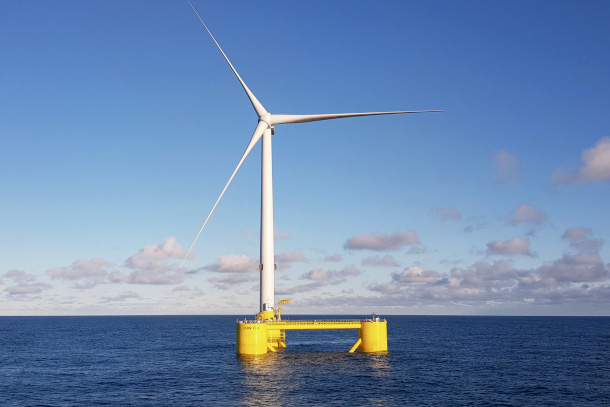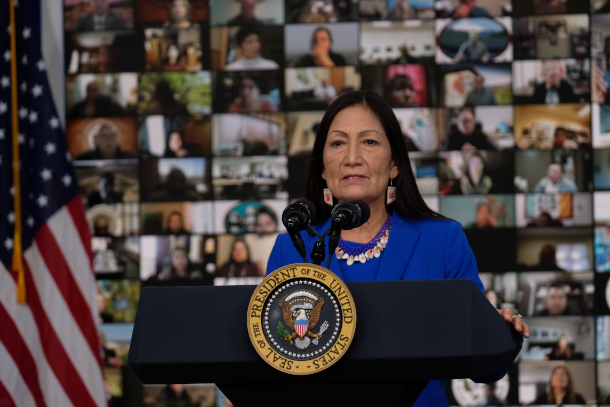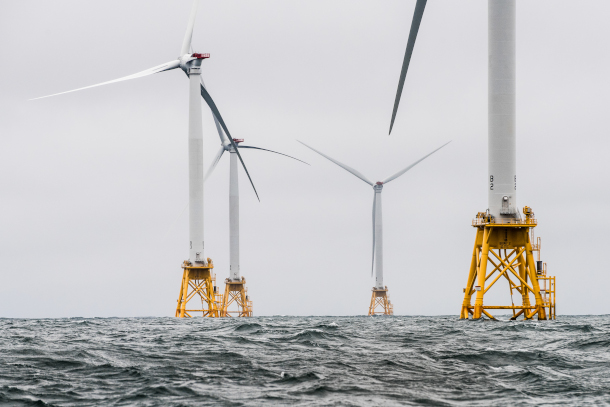California Wind Power Breakthrough
Air Date: Week of October 21, 2022

9.5 MW floating wind turbine deployed at Kincardine Offshore Wind project off coast of Aberdeen, Scotland. (Photo: Courtesy of Principle Power)
As part of President Biden’s goal to supply 30 gigawatts of offshore wind energy by 2030, the Biden administration announced an upcoming sale of federal leases for innovative floating offshore wind sites in the deep waters along the California coast. The wind energy sector is also getting a boost from the clean energy tax credits in the Inflation Reduction Act and additional support in the bipartisan Infrastructure Law. Adam Stern, executive director of Offshore Wind California, joins Host Steve Curwood to explore the bright future for offshore wind in the state and why the oil and gas industry has expertise that can be put to good use for this untapped resource.
Transcript
CURWOOD: From PRX and the Jennifer and Ted Stanley studios at the University of Massachusetts Boston, this is Living on Earth. I’m Steve Curwood.
DOERING: And I’m Jenni Doering
Nowhere is hungrier for more renewable energy than the state of California, with reduced hydropower output this summer during a blistering heatwave and drought. But help is now on the way. In a game changing move, the Biden Administration just announced that bidding for federal leases for floating offshore wind sites along the California coast will begin December 6th.
CURWOOD: Ocean water is so deep close to the California shore that fixed platforms aren’t practical, but there is plenty of space for floating turbines. Adam Stern is executive director of Offshore Wind California, a trade association, and he says innovation and federal support are making a breakthrough in converting the energy economy. Adam Stern, welcome to Living on Earth.
STERN: Well, thank you. It's a pleasure to be on your program.
CURWOOD: Let's start with the Biden administration just announcing the first ever offshore wind lease sale off California's coast. How's this going to work? And what does this mean for offshore wind?
STERN: This is a very exciting moment that has been building for several years now. What the announcement meant today was that the Biden administration is going to conduct a lease auction for five lease areas off the California coast. They collectively could produce as much as five gigawatts of electricity, enough to power 4 million or more homes in California and be a critical addition to California's clean energy grid for the future.
CURWOOD: Along with the announcement of the offshore wind leasing sale for California, how does the Inflation Reduction Act and its tax credits affect the outlook for the wind energy sector, in California in particular, but also generally, as well?
My Administration has set a course for deploying 30 gigawatts of offshore wind by 2030 – enough to power 10 million homes.
— President Biden (@POTUS) September 17, 2022
And we’re taking new steps to develop floating turbines that will unlock more clean energy and create jobs up and down the supply chain.
STERN: There are some excellent provisions in the IRA that will help the offshore industry nationally. In particular, there's an investment tax credit, that goes up to 30% of the costs of building the offshore wind farms. One critical element of that, Steve, is that they've extended the credits to 2045, which reflects the sustained effort that will be required to build out offshore wind nationally. And then there are also tax credits to support manufacturing of the components of offshore wind farms: the towers, the blades, the platforms that are necessary to construct offshore wind towers. In addition, the IRA includes transmission planning grants, and then separately, the infrastructure law that was passed before the IRA has funds in it to support port development, as well as transmission upgrades to critical things that are necessary to advance offshore wind.
CURWOOD: In sum, how has the market for wind energy, particularly offshore wind energy in California, been changed now by these developments?
STERN: Well, we're just in the middle of one of the most exciting periods of policy momentum that I think California and the nation has ever seen. Just a few months ago, the state committed to a planning goal of five gigawatts of offshore wind by 2030 and up to 25 gigawatts by 2045. That together with the Biden administration's initiatives to announce the time and date of the auction for the first leases off California, these together present, I think, a very promising future for offshore wind and enable us to take advantage of this resource that up until now has been untapped.
CURWOOD: Talk to me about the floating platforms that are going to be required for this. This really hasn't been done much in this country at all, if I understand correctly.
STERN: We're fortunate to have the marvelous engineering achievements, largely developed by the oil and gas industry, to create floating platforms, which is going to unlock offshore wind resources that otherwise would not be available. And with the floating platforms tethered to the bottom of the ocean with cables, and supported by very advanced technology that helps them to be positioned in areas that maximize the wind resource, we're going to be able to get use of some of the most powerful resources in the world. And on top of that, we're going to be able to have these offshore wind farms located 15 to 20 miles offshore. It opens up 60% of the waters that would otherwise not be usable for offshore wind.

Secretary Deb Haaland is a champion for offshore wind energy and worked to develop the Biden administration's plan to supply 30 gigawatts of offshore energy by 2030. (Photo: US Department of Interior, Flickr, CC BY SA 2.0)
CURWOOD: And I guess there's a maintenance advantage, too, huh?
STERN: Yeah, there's an exciting aspect of this, which is that you can actually take an individual wind turbine and tower and disconnect it from its mooring lines, tug it into port, have it go through a maintenance regime to fix and replace any broken components, and then tug it back out and put it in position for years of additional service.
CURWOOD: So on that point, what are the risks environmentally, of having these big floating platforms with wind turbines on them?
STERN: In California, at least so far, the studies that the Federal Bureau of Ocean Energy Management has done determined that the impacts would be minimal. We want to protect marine and coastal resources. I believe this is a time we can have clean energy and a healthy environment, and it's critical to the task we have ahead of ourselves of fighting climate change.
CURWOOD: And what about the birds? Some people say, “Oh, those big blades get the birds.”
STERN: By being 15 to 20 miles out, we'll be away from the densest population of birds, but there will be some. And there are also efforts to learn about the migration patterns and if necessary, adjust some of the operation schedules of the offshore wind towers.
CURWOOD: Adam, tell me what new technologies and innovations are you hoping to see to support offshore wind energy?
STERN: See, one of the most exciting developments about offshore wind is that it offers the promise of developing an entirely new clean energy industry for California and the nation. With tens of thousands of jobs, we are already seeing the transition underway where positions that existed in oil and gas have a lot of skills and experience that can be used in offshore wind, and we're excited to advance and accelerate that transition. We also will be able to take advantage of the floating platform technology, which has been now tested in significant size and those floating projects are growing in scale. And by the time the projects will be built in California, we'll be able to make them large enough so that a single tower and turbine setup can generate as much as 15 megawatts of power.
CURWOOD: That's a lot of power. I mean, that's pretty huge.
STERN: The scale is really impressive. And that's one of the most exciting aspects of this. The fact that we can bring this power at a time of day when we need it most going forward as we work to electrify everything. Offshore wind has a wonderful complementary characteristic to support the onshore solar and onshore wind and hydro that we already have in our clean energy portfolio.

The Block Island Wind Farm off the coast of Rhode Island is the first US offshore wind farm. According to US officials, most offshore wind farm sites in the United States are in deep-water areas such as off the coast of California and Oregon that require floating platforms unlike the fixed ones pictured above. (Photo: Dennis Schroeder, Flickr, NREL, CC-BY-ND-ND-2.0)
CURWOOD: Adam, to what extent was the Inflation Reduction Act, was that legislation necessary in order to give meaning to the government's call that they're going to start leasing for offshore wind energy in California?
STERN: It's an enormous boost. This is a critical element in bringing the cost of offshore wind down to competitive levels. Another complementary initiative that the Biden administration launched just a few weeks ago, is an offshore wind shot program. And the goal of the floating wind shot program is to bring the cost down by 70% by 2035, and have 15 gigawatts of offshore wind in the United States off our coasts, also by 2035.
CURWOOD: So Adam Stern, talk to me about your association. What businesses are part of Offshore Wind California?
STERN: Our business group is a coalition of offshore wind developers and technology firms. They include a mix of pure renewable energy companies and then others that are actually oil majors, like BP and Shell who are seeing the future in offshore wind and are excited about the California market. They have a lot of experience building big projects in deep ocean waters, a lot of technology that they've used in oil and gas extraction, which is now being repurposed for the benefit of developing renewable energy in our oceans and taking advantage of the powerful winds that we have off our coasts. In a way, Steve, we're seeing the transition from fossil fuel to clean energy in real time.
CURWOOD: Adam Stern is executive director of Offshore Wind California. Thanks so much for taking the time with us today.
STERN: It's been a pleasure to be on Living on Earth with you, Steve. Thank you.
Links
More on the numbers of what the Inflation Reduction Act includes
Statement about the Dec 6, 2022 lease auction by Offshore Wind California
Living on Earth wants to hear from you!
Living on Earth
62 Calef Highway, Suite 212
Lee, NH 03861
Telephone: 617-287-4121
E-mail: comments@loe.org
Newsletter [Click here]
Donate to Living on Earth!
Living on Earth is an independent media program and relies entirely on contributions from listeners and institutions supporting public service. Please donate now to preserve an independent environmental voice.
NewsletterLiving on Earth offers a weekly delivery of the show's rundown to your mailbox. Sign up for our newsletter today!
 Sailors For The Sea: Be the change you want to sea.
Sailors For The Sea: Be the change you want to sea.
 The Grantham Foundation for the Protection of the Environment: Committed to protecting and improving the health of the global environment.
The Grantham Foundation for the Protection of the Environment: Committed to protecting and improving the health of the global environment.
 Contribute to Living on Earth and receive, as our gift to you, an archival print of one of Mark Seth Lender's extraordinary wildlife photographs. Follow the link to see Mark's current collection of photographs.
Contribute to Living on Earth and receive, as our gift to you, an archival print of one of Mark Seth Lender's extraordinary wildlife photographs. Follow the link to see Mark's current collection of photographs.
 Buy a signed copy of Mark Seth Lender's book Smeagull the Seagull & support Living on Earth
Buy a signed copy of Mark Seth Lender's book Smeagull the Seagull & support Living on Earth

